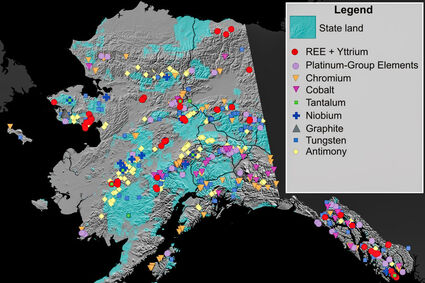Alaska is Well-Positioned to Lead the Nation's Critical Minerals Industry
North of 60 Mining News – August 19, 2022
Last updated 8/18/2022 at 2:06pm

Peggy Greb, U.S. Department of Agriculture
Nearly all 50 of the minerals and metals on the U.S. Geological Survey's 2022 list of critical minerals are found in Alaska, including the suite of rare earth elements. Rare earths in the photo above (clockwise from top center): praseodymium, cerium, lanthanum, neodymium, samarium, and gadolinium.
Modern society depends on the responsible development of a wide variety of minerals and metals.
These commodities are used in numerous consumer products, such as cellular phones, computers, televisions, and automobiles. They are also extremely important for powering the transition from a fossil fuel-based economy to one in which renewable energy is a major part of the energy mix.
Many of these commodities have been designated as "critical minerals" by the U.S. federal government because they are essential for U.S. economic and national security, but today their supply is totally controlled by trading partners that have adversarial relationships with the United States.
Alaska's resource and mineral abundance means we can play a major role in our country's success by providing a secure source of these critical minerals.
State of Alaska agencies encourage mineral-resource exploration in many ways. Those agencies and programs we lead provide regional-scale geoscience datasets and scientific information to encourage exploration and coordinate the well-established processes and robust permitting systems we have in place to take prospects into production and grow the domestic critical minerals industry in Alaska.
Geology
Alaska is blessed with tremendous mineral abundance. We have more than 7,400 documented mineral prospects statewide, and they represent a wide variety of ore deposit types, many of which have associated critical minerals.
Nearly all of the 50 critical mineral commodities listed by the U.S. Geological Survey in 2022 are present in Alaska.
Alaska is currently producing zinc and germanium, has high near-term potential for producing graphite, cobalt, and rare-earth elements, and has historically produced many of the other critical minerals. Multiple mineral belts that cover much of the state also have a high potential to contain critical minerals.
One of the goals of our work is to make information about Alaska available to explorers and investors all around the world. With funding from the State of Alaska and the U.S. Geological Survey, the Alaska Division of Geological & Geophysical Surveys (DGGS) takes an integrated approach to mapping Alaska's high-potential critical mineral belts.
Detailed geological maps, at 1:100,000-scale or larger, are needed to provide sufficiently detailed context for explorers to focus limited exploration dollars on areas with the highest potential for critical mineral discoveries.
Areas of focus are selected in consultation with the division's Geologic Mapping Advisory Board. These areas are first covered by airborne geophysics that allows geologists to see through ground cover and detect geological features at depth.
This data is then used by field mapping teams to guide "boots-on-the-ground" bedrock geologic mapping at 1:100,000-scale. Geophysical survey data, the bedrock geologic map, and supporting geochemical data are published and available for free on the division's website.
These baseline data products provide the framework for understanding the critical mineral potential of Alaska's mineral belts and facilitate industry explorers in making mineral discoveries.
If prospects are proven to have economic mineral resources, and the developer secures all required federal/state/local authorizations, the resulting mines become the start of the critical mineral supply chain.
Simply put, we are the first step in mining critical minerals in Alaska, where the United States controls the supply.
Permitting
Permitting in Alaska follows a rational and rigorous process across multiple agencies. Numerous permits and approvals from state, federal and local government agencies are required before development and operation of a hardrock mine in Alaska can begin.
The State of Alaska has developed the Large Mine Permitting Team within the Office of Project Management and Permitting (OPMP) to coordinate much of the required state agency review and permitting processes for mining projects. This team's purpose is to ensure that mine permitting is legally defensible, coordinated, timely, and transparent for both the applicant and the public.
For applicants that choose to participate in the coordinated permitting process, OPMP assigns a project coordinator who serves as the primary state contact and coordinates with state and federal regulatory agencies through a team approach.
Each Large Mine Permitting Team is an interagency group of regulatory experts that works cooperatively with large mine applicants and operators, federal resource agencies, and the Alaska public to ensure that projects are responsibly designed, operated, reclaimed, and monitored consistent with state laws and regulations.
The public, and public input, are a key part of this process. Alaska's coordinated permitting process typically results in changes to proposed project elements to address public input and regulatory compliance. This approach makes it more likely that projects ultimately receive approval and stay compliant through the life of the project – and that the public has transparent, accessible information about projects at every stage.
Looking Forward
The Alaska Department of Natural Resources – home to both the Division of Geological and Geophysical Surveys and the Office of Project Management and Permitting – also includes the Division of Mining, Land and Water.
By having all of these agencies housed within one state department, Alaska is well-positioned to lead the growing national critical minerals industry.
Next week, policymakers, agency representatives and industry leaders will meet in Fairbanks at the Alaska's Minerals: A Strategic National Imperative summit.
As the title suggests, our state's mineral resources are critical to national security as well as the U.S. economy and clean energy transition goals. DNR staff will be participating as moderators, presenters and attendees at this exciting conference. We hope to see you there!
David LePain is the State Geologist and Director of the Division of Geological and Geophysical Surveys within DNR. Kyle Moselle is the Executive Director of DNR's Office of Project Management and Permitting. Melanie Werdon is Chief of the DGGS Mineral Resources Section. Along with acting DNR Commissioner Akis Gialopsos, they are speakers at the Alaska's Minerals: A Strategic National Imperative summit in Fairbanks on August 22-23. The Department of Natural Resources' mission is to develop, conserve and maximize the use of Alaska's natural resources consistent with the public interest.

















Reader Comments(0)